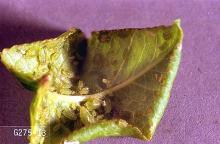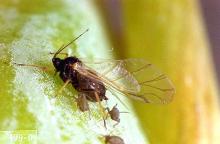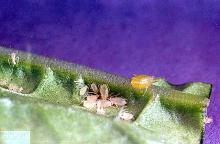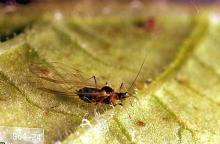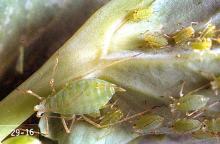Includes
Bean aphid (Aphis fabae)
Green peach aphid (Myzus persicae)
Pea aphid (Acyrthosiphon pisum)
Potato aphid (Macrosyphum euphorbiae)
Pest description, crop damage and life history
See:
Common Pests of Vegetable Crops
Pest monitoring Check fields frequently after seedling emergence. If aphids become numerous, increase frequency of sampling. Aphids often are concentrated in hot spots or near the field margin. Note the presence of any hot spots but avoid sampling only those areas. Also, be sure to look for evidence of biological control, i.e., the presence of predators, parasitoids (aphid mummies), and disease. Aphid flights are most common during periods of moderate temperatures (60° to 80°F). Monitor fields particularly closely during April and May.
Management-biological control
Many parasitoids and predators attack aphids. Early year aphids have many natural enemies that frequently bring them under control later in the year. Among the more common predators are lady beetles and their larvae, lacewing larvae, and syrphid fly larvae. Populations of green peach aphids are reduced in winter by the insect pathogenic fungus Entomophthora aphidis.
Monitor the proportion of aphid mummies relative to unparasitized aphids and the numbers of predators such as lady beetles. If the proportion of mummies is increasing, or predators appear to be gaining control, and aphid populations are not yet damaging, avoid sprays that will disrupt these natural enemies. Most materials available for aphid control are highly disruptive of natural enemy populations.
Management-cultural control
Destroy infested crops immediately after harvest to prevent dispersal. Destroying weed hosts late in the year may help destroy overwintering populations. Roguing diseased plants early may help slow the spread of aphid-vectored diseases. Aphid populations tend to be higher in crops that are fertilized liberally with nitrogen.
Home gardeners can often get effective control by washing aphids with a strong stream of water.
Management-chemical control: HOME USE
Apply to both tops and undersides of leaves.
- acetamiprid
- azadirachtin (neem extract)-Some formulations are OMRI-listed for organic use.
- bifenthrin (often as a mix with zeta-cypermethrin)
- carbaryl
- esfenvalerate
- gamma-cyhalothrin
- insecticidal soap (often as a mix with other ingredients)-Some formulations are OMRI-listed for organic use.
- malathion
- plant-derived essential oils (peppermint, rosemary, thyme, etc.)-Some formulations are OMRI-listed for organic use.
- pyrethrins (often combined with other ingredients)-Some formulations are OMRI-listed for organic use.
- zeta-cypermethrin
Management-chemical control: COMMERCIAL USE
- acetamiprid (Assail 30SG) at 0.047 to 0.1 lb ai/A. PHI 7 days. REI 12 hr. Retreatment interval 7 days. Limit 3 treatments per season. Do not exceed 0.3 lb ai/A per acre per year. Bee Hazard: Do not apply this product while bees are actively visiting the treated area. Lower rates allow maximum survival and faster rebound of natural enemies of insect pests.
- alpha-cypermethrin (Fastac EC) at 0.02 to 0.025 lb ai/A. PHI 1 day. REI 12 hr. Retreatment interval 5 days. Do not exceed 0.075 lb ai/A per season.
- Beauveria bassiana (Mycotrol ESO) at 0.25 to 1 quart/A. PHI 0 days. REI 4 hr. OMRI-listed for organic use.
- bifenthrin (Sniper) at 0.033 to 0.1 lb ai/A. PHI 3 days. REI 12 hr. Do not exceed 0.2 lb ai/A per year.
- bifenthrin/imidacloprid (Brigadier) at 0.06 to 0.087 lb ai/A. PHI 7 days. REI 12 hr. Do not exceed 0.13 lb ai/A imidacloprid and 0.13 lb ai/A bifenthrin per season. Retreatment interval 7 days.
- bifenthrin/zeta-cypermethrin (Hero EW) at 0.04 to 0.1 lb ai/A. PHI 3 days. REI 12 hr. Retreatment interval 5 days. Do not exceed 0.266 lb/A per season.
- Chromobacterium subtsugae (Grandevo) at 0.6 to 0.9 lb ai/A per 100 gal. PHI 0 days. REI 4 hr. OMRI-listed for organic use.
- chlorantraniliprole/lambda-cyhalothrin (Besiege) at 0.06 to 0.1 lb ai/A. PHI 7 days. REI 24 hr. Retreatment interval 5 days. Do not exceed a total of 31.0 fl oz of Besiege or 0.12 lb ai of lambda-cyhalothrin or 0.2 lb ai of chlorantraniliprole per acre per growing season. Do not graze livestock or harvest vines for forage or hay.
- cyantraniliprole (Verimark) at 0.088 to 0.176 lb ai/A at planting. PHI 0 day. REI 4 hr.
- dimethoate (Dimethoate 4E) at 0.25 to 0.5 lb ai/A. PHI 0 days. REI 48 hr. Retreatment interval 14 days. Do not exceed 1.0 lb/A per year. Do not feed treated vines.
- esfenvalerate (Asana XL) at 0.03 to 0.05 lb ai/A. PHI 3 days. REI 12 hr. Do not exceed 0.2 lb ai/A per year. Do not allow livestock to graze treated fields. Do not harvest treated bean vines for livestock forage, fodder or hay.
- flonicamide (Beleaf 50SG) at 0.089 lb ai/A. PHI 7 days. REI 12 hr. Limit 2 treatments. Do not exceed 0.089 lb/A per year.
- flupyradifurone (Sivanto 200 SL) at 0.09 to 0.14 lb ai/A. PHI 7 days. REI 4 hr. Retreatment interval 10 days. Do not exceed 0.365 lb ai/A per season.
- gamma-cyhalothrin (Declare) at 0.01 to 0.015 lb/A. PHI 7 days. REI 24 hr. Retreatment interval 5 days. Do not graze. Do not exceed 0.06 lb ai/A per season. Do not graze livestock in treated areas or harvest vines for forage or hay.
- imidacloprid (Admire Pro) at 0.043 lb ai/A foliar or 0.25 to 0.375 lb ai/A soil applied. PHI 7 days foliar; 21 days soil. REI 12 hr. Do not exceed 0.13 lb ai/A foliar or 0.375 lb ai/A soil applied per season. Foliar retreatment interval 7 days.
- insecticidal soap (M-Pede) at 1 to 2% solution. Potassium salts of fatty acids. See label for rate. PHI 0 days. REI 12 hr.
- Isaria fumosorosea (PFR-97 20%WDG) at 1 to 2 lb product per acre. PHI 0 days. REI 4 hr. Repeat every 3 to 10 days as needed. OMRI-listed for organic use.
- lambda-cyhalothrin (Warrior II) at 0.02 to 0.03 lb ai/A. PHI 7 days. REI 24 hr. Retreatment interval 5 days. Do not exceed 0.12 lb ai/A per year. Do not graze livestock in treated areas or harvest vines for forage or hay. Washington only.
- malathion (Agri Solutions Malathion 5) at 0.61 lb ai/A. PHI 7 days. REI 12 hr. Retreatment interval 7 days. Do not graze or feed foliage to livestock. Limit 2 treatments per season.
- methomyl (Lannate SP) at 0.45 to 0.9 lb ai/A. PHI 1 to 3 days for beans, and 3 days for feeding vines, 7 days for hay. REI 48 hr. Do not exceed 4.5 lb ai/A per year.
- phorate (Thimet 20G)-Do not exceed 1.5 lb ai/A. PHI 60 days. REI 48 hr, or 72 hr if annual rainfall is less than 25 inches. At planting time only. Do not graze or feed to livestock.
- spirotetramat (Movento) at 0.06 to 0.08 lb ai/A. PHI 1 day. REI 24 hr. Reentry interval 7 days. Do not exceed 0.16 lb ai/A per year. Retreatment interval 7 days.
- sulfoxaflor (Transform) at 0.023 to 0.031 lb ai/A. PHI7 days. REI 24 hr. Retreatment interval 14 days. Do not exceed two consecutive applications per crop. Do not exceed 0.266 lb ai/A per year.
- zeta-cypermethrin (Mustang) at 0.04 to 0.05 lb ai/A. PHI 1 day. REI 12 hr. Retreatment interval 5 days. Do not exceed 0.3 lb ai/A per season.


